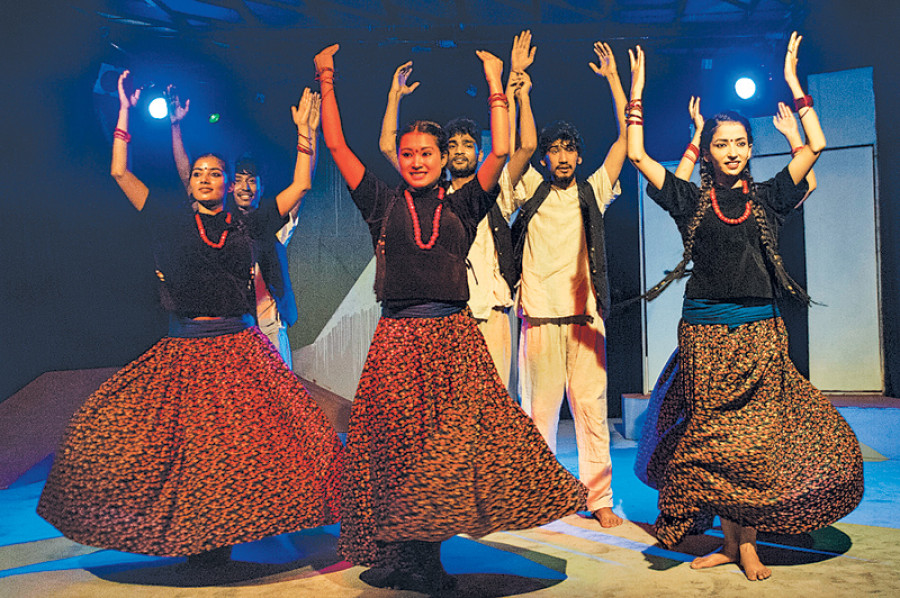Miscellaneous
Triple delight
Jyanmaya, a dramatisation of Sarubhakta’s eponymous epic poem, presents a unique amalgamation of dance, poetry and music, all weaved into a tragic love affair
Timothy Aryal
In July this year, a team of dance enthusiasts—the duo of Namrata KC and Kripa Bajracharya—established an organisation, Asthetic Dance Studio, with the aim of adding a brick to the almost non-existent Nepali dance scape. The studio specialises in Kathak dance, a classical dance form that originated in India; Kathak is a term derived from the Sanskrit Katha, which translates to telling a story. The duo’s goal was to popularise the narration of tales through dance, a task the organisation has taken to heart.
“What we strive for is to present an art form that works as a confluence of dance and the fine arts, and one that gives ample room for storytelling and music,” says Namrata KC.
Not long after the formation of Aesthetic Dance Studio, the duo ventured into hosting a dance workshop—Kathakanksha—that ran for a month at the Rastriya Nachghar in the Capital, and featured a total of 20 aspiring dancers and artists.
Following that, the duo directed a musical Swan Lake collaborating with actor Najir Hussein.
Aesthetic Dance Studio, still in its infancy, has now come up with another project—this time a play, titled Jyanmaya—which is currently being staged at the Mandala Theatre in the Capital. The play is a dramatisation of the peerless Sharu-Bhakta’s epic of the same name.
Speaking about the conception of the play, KC, who directed the play, said, “Poetry has always fascinated me. We wanted to stage a drama and were mulling over the sources. Then one day, while we were discussing Jyanmaya in a coffee shop, Anup Baral approached us and said that this would be the apt source, which only fueled our excitement. We confirmed that Jyanmaya, which is a long tragic poem in verse about the rustic life in western Nepal, would be the one.”
The team then went on to provide a month-long course that also involved rehearsal of the play featuring a dozen artists, dancers and non-dancers, who are featured in the play.
Jyanmaya takes off with a series of deftly choreographed sequences which tickles the audience’s fancy and keeps them baited for what lies in store. A unique amalgam of poetry, music and dance, the play tells a simple story with the use of expression and a minimal use of dialogues. Whatever dialogue it uses, it derives from the epic poem itself.
As soon as the ensemble of nine performers enter the stage—with female actors in choli and fariya; and male actors in waist-coats and suruwal—the audience becomes aware that we are somewhere in the hills of western Nepal, the setting the epic poem is based in. This sense of credibility is further heightened by the meticulous sets designed by Ghanashyam Shrestha.
The story, however minimal in its structure, is heartbreaking in its effect. A classic tragedy. Mane (played by Riyar Rai) is a struggling villager, who cuts wood in exchange for bread and butter. Kanchi (played by Kripa Bajracharya) is a young teenage girl, troubled by her father’s drinking habits. One day, the father tries to marry her to a lahure who has just come to village from abroad. Kanchi refuses. Then she meets Mane, they fall in love, and elope. But getting by is not easy. They meet a group of porters, who carry apples from the mountains to a town in hills. Mane and Kanchi too start commuting upwards and downwards with the group on the narrow and harsh trails.
Then one day, while still with a basket of apples on his back, Mane fall off a cliff. Kanchi can’t bear it and it is suggested that she too plunges to her death in despair. At the premiere of the play last Tuesday, Sarubhakta spoke about how the epic was conceived—of how the travails for survival of residents in Mustang touched and inspired him to come up with the elegy.
The story of this treacherous strive for survival in director KC’s rendition flows seamless, and if you are to forgive some glitches the performances are largely well-executed—although the dance performance by the male crew did leave a lot to be desired.
Nepali theatre is currently undergoing through an acute shortage of plays written about our time; that means theatre artists have had to retreat to our literary heritage. But what we have been offered are largely up to the mark; they revive our heritage and further add to the narrative—enhancing their value for the modern times.
Jyanmaya does just that. Further, Jyanmaya is also noteworthy for it blends three different art forms into one tragic narrative.




 17.12°C Kathmandu
17.12°C Kathmandu










